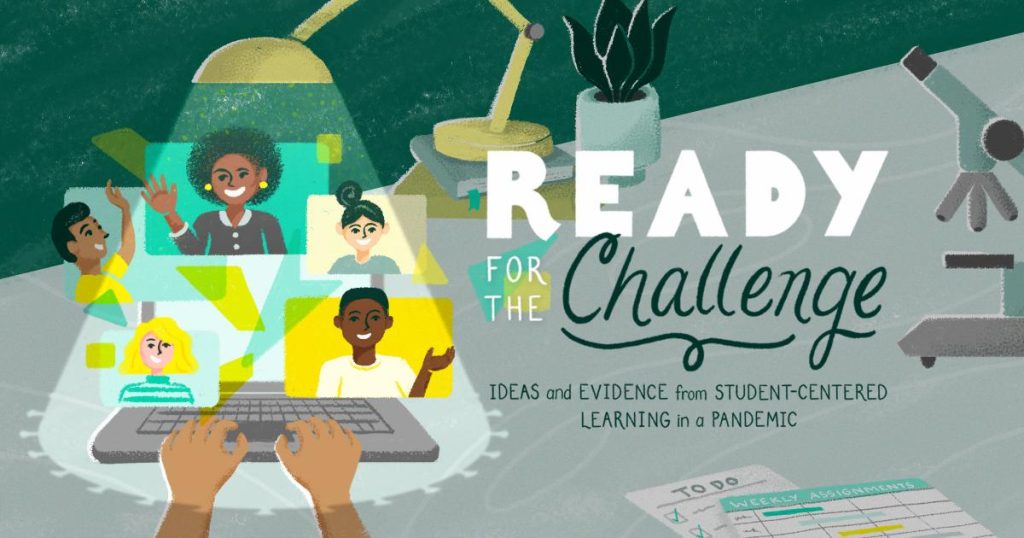Illustration: Khou Vue for Education Evolving.
We’re delighted to announce today the launch of a new year-long blog series, Ready for the Challenge: Ideas and Evidence from Student-Centered Learning in a Pandemic.
Never have so many students, families, and educators experienced a year so thoroughly disrupted. As schools have shifted to distance learning, some have embraced that, now more than ever, student-centered learning approaches are needed—to enable students to learn at their own pace and place, according to plans personalized to their needs.
In this series, we’ll hold up stories of these student-centered innovators. We hope their lessons learned will be helpful for other educators wanting to use this period of disruption to pivot their schools toward a more student-centered future.
We’ll place particular focus on a question we get often, especially in this period: what measures, data, and other forms of evidence are student-centered schools using to gauge and document success, and to adapt learning as needed?
Our end goal is both to share practical lessons for educators, and also to develop the broader argument and evidence base that student-centered approaches are critical not just in the grip of Covid-19—but to, finally, equitably serve all students as we pull ourselves beyond it.
The year that amplified long-standing equity challenges
As schools gradually resume in-person learning and we look towards our vaccinated future, it’s tempting to say: good riddance. Let’s close this chapter and finally get ‘back to normal.’
That would be a mistake. The challenges and inequities we saw this year were not new, but rather amplified versions of experiences long familiar to many. Consider all the headlines we’ve seen: about inconsistent access to learning; widespread disengagement; lack of perceived relevance; learning loss and resulting gaps in knowledge; discontinuity with students’ families and communities; and the emotional stress and trauma that comes with it all.
Ask yourself, who has experienced these challenges, historically? Why now—when these phrases describe the experiences of the vast majority, not just those our system has consistently underserved—have these headlines so dominated the news?
These questions should make clear that we need an education system that, by design, better meets each student at times and places that work for them, adapts to their academic needs, honors their unique interests and potential, and sees them, their families, and their communities represented, welcomed, and included as partners.
By asking how student-centered learning has addressed these challenges in this period of amplified inequity we can not go back to normal… but forward to better and more equitable.
Series focus: distilling student-centered practices and success indicators
The series, which will feature new blog posts each month throughout 2021, will tell the stories of how five schools across the country have used student-centered approaches in the pandemic. In particular, we’ll showcase the strategies they have used to gauge and document their success, and stay accountable to themselves and their communities.
In addition to profiles of specific sites, we will synthesize common practices, indicators used, and evidence gathered, as well as interpret the data emerging across the broader education community during this period.
As described above, we’ll place special focus on student-centered practices used to advance educational equity. Covid-19 has exacerbated inequity in many troubling ways. At the same time, it has fundamentally reconfigured how many students experience school, allowing some to find success they were previously denied in traditional environments.
In sum, our work will seek to answer four questions:
- What elements of student-centered learning have schools implemented in this pandemic era?
- How are they documenting evidence and measuring success (including, for example, academic achievement, engagement, social and emotional learning, and other local measures)?
- What evidence have they gathered and results have they produced on those measures?
- How have they ensured equity and accountability in this period?
As an educator recently told us: this year forced us to rethink everything. Many things have gone worse; but some things have gone better. We’re here to sift out the ‘what’ and ‘how’ of the latter as we move forward.
Please follow along with us on this blog. You can also sign up to receive posts by email.
We are grateful to the Leon Lowenstein Foundation for their generous financial support for this series.


